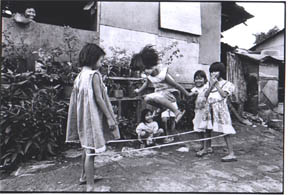|
CHILDREN'S LABORATORY FOR DRAMA IN EDUCATION Coalition is a group of organisations, professional individuals, community leaders,
students and volunteers dedicated to the use of PLAY and GAME as TEACHING AND LEARNING TOOLS!!!
We have espoused and utilised Drama in Education in:
1. Pioneering of the present work on Street Education for street children programmes in 21 urban centres in the Philippines.
2. Training and organising alternative theatre groups of both in and out of school children and youth in many parts of
the country in partnership with local government units and local divisions of schools.
3. Establshing an alternative school called PAARALANG; PANTAO for working children at the Payatas dumpsite in partnership
with a people's organisation.
4. Developing a Convention on the Rights of the Child (CRC) based Early Childhood Care and Development curriculum.
5. Organising Peer Education and Counselling Programme in partnership with the Department of Social Welfare and Development.
6. Setting up Community Advisory Committees for Preventive Health Education.
7. Integrating Alternative Health Education and Communications Strategies of the Philippine National Red Cross in partnership
with the Community Health and Nursing Service.
8. Organising children and youth groups including the National Street Children's Association, Team for KIDS, and other
community and school based groups.
9. Development of alternative information, education and; communication materials for parents, teachers,; social workers,
and other significant stakeholders in partnership with local and international organisations including UNICEF, UNAIDS, RTRC
ASIA, WHO, PNRC,ILO-IPEC, Christian Children's Fund, Save the Children Alliance, ERDA, Plan International; and the Children
and AIDS Network.
 CHILDREN'S LAB joins the society of people that seeks to address the situations of children we see everyday.
CHILDREN'S LAB invites you to join the trek to
REDISCOVERING A WORLD OF CHILD FRIENDLY PEOPLE.
And the trek begins with you.
Take a look at the child or children nearest you, and what do you see?
Are you a Parent? Look at your own child.
How is she? Is she really happy?
Look at your nephew, your niece, your younger brother or sister.
Is she or he happy? Why? Why not?
|
 |
|
|
|
 |
 |
 |
|
WHAT IS DRAMA IN EDUCATION
The Children's Laboratory
Experience in the Philippines
Drama In Education and Children'S Theatre espouses the use of PLAY and GAME as teaching and learning tools. PLAY as in acting
out, being, and creating characters and situations that help learners concretise conceptual ideas through simulated experiences;
and GAMES which, pertain to the usual and common "winning" oriented activities that children (and adults) engage
in. Both Play and Game are processes of DRAMA, which further refers to an interaction between and among one or more people.
Drama in Education is a method used in classroom activities and other alternative venues to explore ideas and develop
communications skills. Educational drama makes use of spontaneous role-play, various improvisation techniques, and games to
explore concepts, ideas and attitudes; as well as to encourage discussion. It is important for the teacher / facilitator
to note that Drama:
Happens everyday and everywhere
There is drama outside the four walls of the stage (as opposed to theatre)
These dramatic moments can be tools for teaching and learning.
PLAY encourages the children to express their personal experiences, thoughts, and feelings and to recognise that there
are different options open to them in their choice of behaviour patterns. It can thus, explore values without imposing them.
During the drama (play) the teacher/facilitator can work with the learners and helps them relate their everyday experiences
with others. Drama allows everyone to be in someone else's shoes by experiencing feelings of others and think from their
point of view.
Child's Play involves (specially to the very young) not only acting but also BEING.
GAMES on the other hand are valuable learning tools for very young children. As they are in their original forms, games
teach important lessons about sharing, co-operating, and working to achieve specific goals as they increase children's self-esteem.
Games come in many forms, throughout history, young people in all cultures have created games according to their needs:
Games may be generally classified under the following structures:
1. Games in which players perform the same activity, taking turns or together example: PIKO (Filipino hopscotch)
2. Acting out games in which players have to specific roles to play: Simon Says
3. Races in which players compete to reach a goal first
4. Capture games in which layers alternate the roles of being chased and object of chase. Example: HABULAN-TAYA (Filipino
Tag game)
5. Physical conflict games in which players stage attack or defence stances: Tug o War, day and night
6. Strategy games which player use physical, mental or both skills to win, ex: PUZZLE
Games help young children build character (coping skills and sprits) as they are faced with challenges. Games also develop
Physical, (agility, co-ordination, strength); Mental (memory, concentration; Intellectual (negotiation, decision making; Emotional,
acceptance of victory and defeat; Spiritually (determination to move on forward, and be one's own ally.
Different from the spontaneous activity of Play, the teacher has to consider the following elements when using Game as
teaching and learning tool:
a) Structure
b) Number of players
c) Groupings
d) Time element
e) Materials
|
 |
|
|
|



